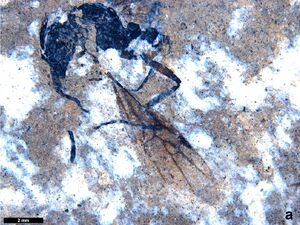Aphaenogaster enspelensis
| †Aphaenogaster enspelensis Temporal range: Oligocene Enspel Formation, Rhineland-Palatinate, Germany | |
|---|---|

| |
| Scientific classification | |
| Kingdom: | Animalia |
| Phylum: | Arthropoda |
| Class: | Insecta |
| Order: | Hymenoptera |
| Family: | Formicidae |
| Subfamily: | Myrmicinae |
| Tribe: | Stenammini |
| Genus: | Aphaenogaster |
| Species: | †A. enspelensis |
| Binomial name | |
| †Aphaenogaster enspelensis Jessen, 2020 | |
The lone Aphaenogaster fossil known from an Oligocene deposit.
Identification
Jessen (2020) - All other Aphaenogaster reproductives, like Aphaenogaster maculate, Aphaenogaster maculipes and Aphaenogaster archaica, have been collected from Oligocene deposits and are informally allocated to the genus Paraphaenogaster. None of these three species were found to have propodeal spines. Gyne of the species Aphaenogaster mayri and Aphaenogaster donisthorpei found in Eocene sediments in Florissant are smaller; their BL is only 7–8mm (Carpenter 1930). In A. mayri, short but distinct spines are reported; in A. donisthorpei, they were not seen. Thus, gynes of A. enspelensis are characterised by the combination of broad-based, large propodal spines and a body length of more than 11 mm. Aphaenogaster enspelensis is the only Aphaenogaster species deriving from Oligocene deposits.
Distribution
This taxon was described from Enspel Formation, Rhineland-Palatinate, Germany (Oligocene).
This species and other fossil ants were collected as part of yearly excavation campaigns between 1995 and 2013 conducted by the Directorate General for Cultural Heritage Rhineland-Palatinate, Directorate Archaeology, Department of Earth History.
Castes
Queen
 
| |
| . | |
Nomenclature
The following information is derived from Barry Bolton's Online Catalogue of the Ants of the World.
- †enspelensis. †Aphaenogaster enspelensis Jessen, 2020 (not paginated), fig. 9a,b (q.) GERMANY (Oligocene)
Unless otherwise noted the text for the remainder of this section is reported from the publication that includes the original description.
Description
Queen
Holotype BLw/ oG: 7.50, HL: 1.98, HW*: 1.82, ED: 0.54, GeL: 0.51, ML: 1.07, MML: 0.75, SL: 1.84, AL: 3.36, AH: 2.42, FWL: 9.15, ScuL: 2.05, ScutL: 0.64, HiTL: 2.11, PH: 0.87, PPL: 0.46 (excl. helcium), PPH: 0.78, HeH: 0.44. Wing venation: 2M-Cu: 0.84, 1Cu: 0.84, 1M: 0.47, m-cu: 0.57, 1RS+M: 0.47, RS+M: 0.51. Indices: CI: 92.0, SI: 101.0, IED/HL: 27.52, IHL/AL: 58.87, Imcu: 56.14, I2RS+M/1RS+M: 109.38, I2RS+M/m-cu: 108.85, I2RS+M/2M+Cu: 61.40. (Because of perspective shift, no measurement is given for PL; it has only been estimated for calculating BL).
Position: Head, alitrunk from dorsolateral, petiole and postpetiole from anterolateral. Gaster missing.
Colour: Black.
BL about 11.32. Head longer than wide, with distinct, rounded occipital corners. Posterior margin of head is indicating a median depression. Clypeus slightly convex in profile. Median part of clypeus with longitudinal striae, anterior clypeus margin here smooth. Eyes located slightly below mid length of head. Mandibles strongly developed, sub-triangular. Apex of left mandible missing. Due to compaction masticatory margin is bended downwards, only three triangle-shaped teeth can be identified. Based on estimation, there should be more than six triangular-shaped teeth. Shape and size of apical tooth is not clear either. Scape slightly surpasses head posteriorly. Head sculpture with wide coarse striae, visible at frons, at clypeus, between antennal sockets and eyes, and at gena. Alitrunk robust, high, arched. Metanotum well developed. Propodeal spines stout with broad base. Gradually descending posterior face of propodeum transversely striated. Scutum and scutellum sculptured rugosely. Tibial spurs on foreleg brushed or combed. At first and second tarsal, segment of protarsus bristles preserved. Wing venation with closed cells mcu, 1+2r and rm. Shape of cell mcu is trapezoid. The vein rs-m does not appear as a direct vertical extension of vein 2r-rs, but branches distally slightly offset from the vein RS. The results is a very short vein 4RS. In all other aspects, the description of the wing venation of the genus applies. Petiole stout with round bar-like peduncle and high distinct node. Petiole’s position is not clear; the node might have been twisted. Anterior face of node steep, tapered and rounded at top. Top of node with longitudinal respectively transverse grooves, depending whether the petiole has been twisted or not. Posterior face of node less steep. Peduncle broadly connected with alitrunk. Postpetiole disarticulated from petiole. Helcium almost round in cross section, its anterior margin is thickened, ventrally with a little invers notch. Node of postpetiole round, domeshaped, not tapered, slightly constricted towards gaster.
Type Material
Holotype: NHMM-PE1997/5555-LS, winged gyne. Enspel Oilshale, Rhineland-Palatinate, Germany. Enspel Formation, Upper Oligocene, MP 28; (24.56–24.79 Ma, Mertz et al. 2007), layer S14.
Abbreviation of specimen numbers:NHMM= Naturhistorisches Museum Mainz; PE = Palaeontology Entomology; 2009 = found in 2009; 6281 = running inventory number of the year; LS = Landessammlung (State Collection). Information on the layer is given. They refer to the standard profile in Felder et al. (1998).
Currently stored in the Directorate General for Cultural Heritage Rhineland-Palatinate, Directorate Archaeology, Department Earth History, Mainz, Germany. In the long term, they will be deposited in the “Typothek” of the State Collection of Natural History Rhineland-Palatinate/Museum of Natural History Mainz, Mainz, Germany (NHMM).
Etymology
Named after the village Enspel in the Westerwald Mountains (Rhineland-Palatinate, Germany), territory of the Lake Enspel Fossil-Lagerstätte.